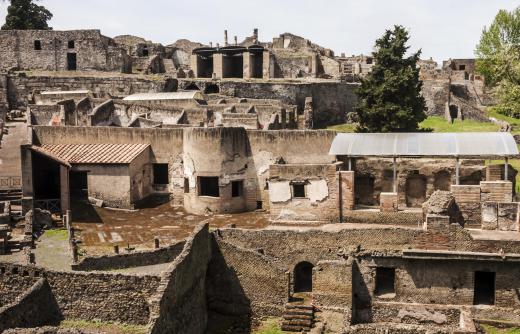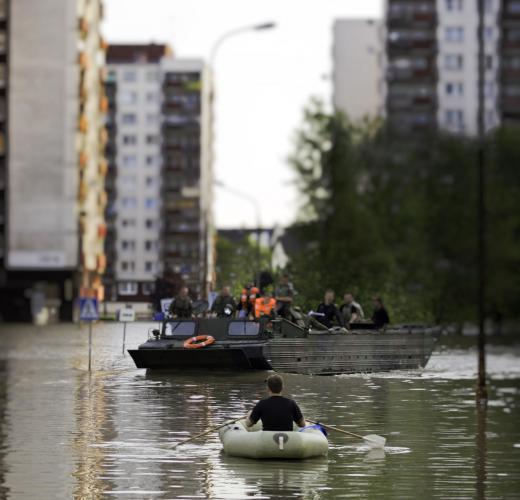What Were the 10 Largest Earthquakes?
Determining the largest earthquakes can be a difficult task, since it depends on how the question is defined. Some people might consider the largest to be those that registered highest on the Richter scale, while others might consider the number of deaths or cost of damages. Additionally, the Richter scale was invented in 1934, so it may be difficult to compare earthquakes that occurred prior to that time with later, more accurate readings.
Earthquakes that occurred before the 20th century are particularly difficult to rate. A major earthquake in Pompeii in the year 62 CE, seven years before the volcanic eruption that would destroy the city, was said to have caused considerable damage. In 1556, an earthquake in Shaanxi province in China was reported to have killed at least 830,000 people, and it is still considered the deadliest quake in history. The New Madrid quake, which struck the US in southern Missouri in 1811, caused the Mississippi River to flow backward. There have been many other severe earthquakes throughout history, the severity of which will likely never be accurately known.
More recent earthquakes have been more accurately measured, and the magnitude of those that occurred before 1934 can be estimated. The ten largest earthquakes, according to measured or estimated magnitude recorded since 1900, are as follows:
| Rank | Date | Location | Magnitude | Estimated Deaths/Damages (USD) |
|---|---|---|---|---|
| 1 | 1960 | Chile | 9.5 | 1,655/$6 million |
| 2 | 1964 | Alaska | 9.2 | 128/$300 million |
| 3 | 2004 | W. Sumatra | 9.1 | 227,898/estimated in the billions |
| 4 | 2011 | Japan | 9.0 | more than 12,000/unknown |
| 5 | 1952 | Russia | 9.0 | none reported/$1 million |
| 6 | 2010 | Chile | 8.8 | 521/$30 billion (est.) |
| 7 | 1906 | Ecuador | 8.8 | 500-1,500/unknown |
| 8 | 1965 | Alaska | 8.7 | none reported/$10,000 |
| 9 | 2005 | N. Sumatra | 8.6 | 1,300/unknown |
| 10 | 1957 | Alaska | 8.6 | none reported/$5 million |

Of the ten largest recorded since 1900, four occurred on or around the continent of Asia, three in North America, and three in South America. The Chilean Earthquake of 1960, largest in terms of measured magnitude, caused damage as far away as Japan, Hawaii, and coastal California.
In terms of lives lost, the 2004 Western Sumatra quake, also known as the 2004 Indian Ocean Earthquake, resulted in the highest death toll for recorded quakes since 1900. The earthquake itself was reportedly felt in regions as far away from the epicenter as Malaysia, Singapore, and Bangladesh. The vast majority of lives were lost in Indonesia due to resulting tsunami, which also hit land masses bordering the Indian Ocean, such as Sri Lanka, India, and Thailand. It spawned further quakes as far away as Alaska.

Most of these earthquakes triggered a tsunami that resulted in death and/or damages to property. Even the 1950 Tibet Earthquake, which at 8.6 magnitude has just been pushed off the top 10 list, resulted in hundreds of deaths due to river flooding. Eight days after the Tibet quake, a landslide, which had formed a natural dam in the Subansiri River immediately after the quake, broke loose, reportedly killing an additional 500 people.

As recorded by the United States Geological Survey, the largest all centered in what is known as the Pacific Rim of Fire. The geological region contains more than 75% of the Earth’s dormant and active volcanoes and is home to about 80% of the biggest earthquakes ever recorded. The region itself runs roughly from the coast of New Zealand, northward along the eastern coast of Asia, across the North Pacific to Alaska, and southward down the entire West Coast of North and then South America.

The Pacific Rim of Fire touches the edges of seven separate tectonic plates: Pacific, Indo-Australian, Eurasian, North American, Cocos, Nazca, and Antarctic. Tectonic plates are huge pieces of the Earth's crust that rest on top of the mantle, a hot, soft layer of compounds that causes the plates to move. It is the shifting of the plates that cause most earthquakes the planet experiences.
AS FEATURED ON:
AS FEATURED ON:















Discussion Comments
Yes its amazing that such a powerful earthquakes will not kill even a single person. Only God knows why.
Considering that the USSR was ruled by Stalin during the time of the earthquake, it is unlikely that he would have let information about the cost of the damage or the lives lost (I mean, what's a few thousand or so to Stalin?) to the rest of the world, or even recorded it anywhere.
We had a 7.1 in my city a few weeks back, and the damage cost for that have been estimated as four billion dollars, substantially more for a considerably smaller quake, inflation or not.
@lokilove - I totally agree with your suggestion that the Russian government withheld damage information about that quake. There is simply no way a 9.1 quake didn't cause any deaths. In addition, there is no way that a quake of that magnitude caused only $1 million in damages. This is especially true given that the modern retrofitting and structural reinforcement didn't exist back then.
That assertion makes sense from a political standpoint as well. It is completely within the realm of possibility that the U.S.S.R. would not report the real figures in an attempt to make themselves look like they're not in a crisis (which would make them look vulnerable to the rest of the world).
I find it curious that the 9.1 in Russia has no deaths reported. Obviously the soviet government has done that, but I don't understand what the purpose would be. There is no way that a 9.1 quake could have happened without at least 1 death in populated area.
The 2 in Alaska show no deaths either. I know that Alaska is huge and sparsely populated, but it still seems impossible to me.
I wonder how big the New Madrid quake had to be in order to cause the Mississippi river to flow backward! I was very near the Northridge quake in 94' and that was a 6.7 and it felt huge to me!
Post your comments